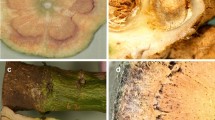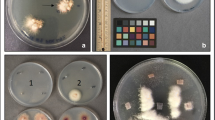Abstract
Symptoms of a vascular wilt were observed on many plants of Lavandula × allardii (hybrid of Lavandula dentata and L. latifolia) cultivated in a nursery near Albenga, Liguria region, Northern Italy. After identification based on morphological characteristic and ITS sequence analysis, the pathogen was identified as Fusarium oxysporum. Eight single-spore isolates obtained from infected tissues were used for a phylogenetic analysis in order to identify the forma specialis. Translation elongation factor 1-α (EF-1α), intergenic spacer (IGS) and three genes encoding for polygalacturonase genes (pg1, pg5 and pgx1) were amplified by PCR. Gene sequences were aligned with other formae speciales of Fusarium oxysporum obtained from GenBank databases in order to build phylogenetic trees. Results obtained for each genomic region showed a unique group with isolates derived from L. × allardii well separated from the other formae speciales. Results obtained, together with pathogenicity tests, allowed us to introduce a new forma specialis named F. oxysporum f. sp. lavandulae.




Similar content being viewed by others
References
Appel DJ, Gordon TR (1995) Intraspecific variation within populations of Fusarium oxysporum based on RFLP analysis of the intergenic spacer region of the rDNA. Exp Mycol 19:120–128
Armstrong GM, Armstrong JK (1981) Formae speciales and races of Fusarium oxysporum causing wilt diseases. In: Nelson PE, Toussoun TA, Cook RJ (eds) Fusarium: diseases, biology and taxonomy. Penn State University Press, University Park, pp 391–399
Baayen RP, O’Donnell K, Bonants PJM, Cigelnik E, Kroon LPNM, Roebroeck JA, Waalwijk C (2000) Gene genealogies and AFLP analysis in the Fusarium oxysporum complex identify monophyletic and non-monophyletic formae speciales causing wilt and rot disease. Phytopathology 90:891–900
Cavanagh HMA, Wilkinson JM (2002) Biological activities of lavender essential oil. Phytother Res 16:301–308
Cosic J, Vrandecic K, Jurkovic D, Postic J (2012) First report of lavender wilt caused by Fusarium sporotrichioides in Croatia. Plant Dis 96:591
Daboussi MJ, Capy P (2003) Transposable elements in filamentous fungi. Annu Rev Microbiol 57:275–299
Davino S, Cacciola SO, Pennisi AM, Li Destri Nicosia MG (2002) Phytophthora palmivora a new pathogen of lavender in Italy. Plant Dis 86:561
Faedda R, Cacciola SO, Pane A, Szigethy A, Bakonyi J, Man in't Veld WA, Martini P, Schena L, Magnano di San Lio G (2013) Phytophthora × pelgrandis causes root and collar rot of Lavandula stoechas in Italy. Plant Dis 97:1091–1096
Fisher NL, Burgess LW, Toussoun TA, Nelson PE (1982) Carnation leaves as a substrate and for preserving cultures of Fusarium species. Phytopathology 72:151–153
Gámez MJ, Jiménez J, Risco S, Zarzuelo A (1987) Hypoglycemic activity in various species of the genus Lavandula. Part I: Lavandula stoechas L. and Lavandula multifida L. Pharmazie 42:706–707
Garibaldi A, Bertetti D, Pensa P, Ortu G, Gullino ML (2015) First report of Fusarium oxysporum causing wilt on Allard's lavender (Lavandula × allardii) in Italy. Plant Dis 99:1868
Gordon TR, Martyn RD (1997) The evolutionary biology of Fusarium oxysporum. Annu Rev Phytopathol 35:111–128
Gullino ML, Katan J, Garibaldi A (2012) The genus Fusarium and the species that affect greenhouse vegetables and ornamentals. In: Gullino ML, Katan J, Garibaldi A (eds) Fusarium wilts of greenhouse vegetable and ornamental crops. APS Press, St. Paul, pp 5–9
Hirano Y, Arie T (2009) Variation and phylogeny of Fusarium oxysporum isolates based on nucleotide sequences of polygalacturonase genes. Microbes Environ 24:113–120
Leslie JF (2012) Genetics and Fusarium oxysporum. In: Gullino ML, Katan J, Garibaldi A (eds) Fusarium wilts of greenhouse vegetable and ornamental crops. APS Press, St. Paul, pp 39–47
Lievens B, Hanssen IM, Rep M (2012) Recent developments in the detection and identification of formae speciales and races of Fusarium oxysporum: from pathogenicity testing to molecular diagnostics. In: Gullino ML, Katan J, Garibaldi A (eds) Fusarium wilts of greenhouse vegetable and ornamental crops. APS Press, St. Paul, pp 47–55
Mbofung GY, Hong SG, Pryor BM (2007) Phylogeny of Fusarium oxysporum f. Sp. lactucae inferred from mitochondrial small subunit, elongation factor 1-α and nuclear ribosomal intergenic spacer sequence data. Phytopathology 97:87–98
Miller AG (1985) The genus Lavandula in Arabia and tropical NE Africa. Notes Roy Bot Gard Edinburgh 42:503–528
O’Donnell K, Cigelnik E (1999) A DNA sequence-based phylogenetic structure for the Fusarium oxysporum complex. Phytoparasitica 27:69–70
O’Donnell K, Kistler HC, Cigelnik E, Ploetz RC (1998) Multiple evolutionary origins of the fungus causing Panama disease of banana: concordant evidence from nuclear and mitochondrial gene genealogies. Proc Natl Acad Sci U S A 95:2044–2049
O’Donnell K, Gueidan C, Sink S, Johnston PR, Crous PW, Glenn A, Riley R, Zitomer NC, Colyer P, Waalwijk C, van der Lee T, Moretti A, Kang S, Kim H-S, Geiser DM, Juba JH, Baayen RP, Cromey MG, Bithell S, Sutton DA, Skovgaard KR, Kistler P, Elliott HC, Davis M, Sarver MBAJ (2009) A two locus DNA sequence database for typing plant and human pathogens within the Fusarium oxysporum species complex. Fungal Genet Biol 46:936–948
Ortu G, Bertetti D, Gullino ML, Garibaldi A (2013) A new forma specialis of Fusarium oxysporum on Crassula ovata. J Plant Pathol 95:33–39
Ortu G, Bertetti D, Gullino ML, Garibaldi A (2015a) Fusarium oxysporum f. Sp. echeveriae, a novel forma specialis causing crown and stem rot of Echeveria agavoides. Phytopathol Mediterr 54:64–75
Ortu G, Bertetti D, Martini P, Gullino ML, Garibaldi A (2015b) Fusarium oxysporum f. Sp. papaveris: a new forma specialis isolated from Iceland poppy (Papaver nudicaule). Phytopathol Mediterr 54:76–85
Perveen K, Bokhari N (2010) First report of Fusarium wilt of Lavandula pubescens caused by Fusarium oxysporum in Saudi Arabia. Plant Dis 94:1163
Putnam M (1991) Root rot of lavender caused by Phytophthora nicotianae. Plant Pathol 40:480–482
Recorbet G, Steinberg C, Olivain C, Edel V, Trouvelot S, Dumas-Gaudot E, Gianinazzi S, Alabouvette C (2003) Wanted: pathogenesis-related marker molecules for Fusarium oxysporum. New Phytol 159:73–92
Ren YZ, Tan H, Li ZJ, Du J, Li H (2008) First report of lavender wilt caused by Fusarium solani in China. Plant Pathol 57:377–377
Tamura K, Stecher G, Peterson D, Filipski A, Kumar S (2013) MEGA6: molecular evolutionary genetics analysis version 6.0. Mol Biol Evol 30:2725–2729
Van der Does HC, Rep M (2007) Virulence genes and the evolution of host specificity in plant-pathogenic fungi. Mol Plant-Microbe Interact 20:1175–1182
Acknowledgements
This work was supported by the European Community’s Seventh Framework Programme (FP7/2007-2013) under grant agreement n° 261752, PLANTFOODSEC “Plant and Food Biosecurity, Network of Excellence”.
Author information
Authors and Affiliations
Corresponding author
Rights and permissions
About this article
Cite this article
Ortu, G., Bertetti, D., Gullino, M.L. et al. Fusarium oxysporum f. sp. lavandulae, a novel forma specialis causing wilt on Lavandula × allardii. J Plant Pathol 100, 391–397 (2018). https://doi.org/10.1007/s42161-018-0084-0
Published:
Issue Date:
DOI: https://doi.org/10.1007/s42161-018-0084-0




